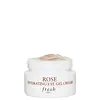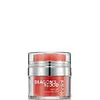What's inside
What's inside
 Key Ingredients
Key Ingredients

 Benefits
Benefits

 Concerns
Concerns

 Ingredients Side-by-side
Ingredients Side-by-side

Water
Skin ConditioningMethyl Trimethicone
Skin ConditioningGlycerin
HumectantPropanediol
SolventPolyglycerin-3
HumectantSqualane
EmollientButylene Glycol
HumectantDimethicone
EmollientHydroxyethyl Acrylate/Sodium Acryloyldimethyl Taurate Copolymer
Emulsion StabilisingGlyceryl Oleate Citrate
EmulsifyingRosa Damascena Flower Water
MaskingChlorella Vulgaris Extract
Skin ConditioningRosa Damascena Extract
MaskingCucumis Sativus Fruit Extract
EmollientVoandzeia Subterranea Seed Extract
Skin ConditioningRhodiola Crenulata Root Extract
EmollientRosa Damascena Flower Oil
MaskingTocopheryl Acetate
AntioxidantDiphenylsiloxy Phenyl Trimethicone
Skin ConditioningCaprylic/Capric Triglyceride
MaskingPoloxamer 407
EmulsifyingDimethicone/Phenyl Vinyl Dimethicone Crosspolymer
PEG-6
HumectantPolysorbate 60
EmulsifyingSorbitan Isostearate
EmulsifyingXanthan Gum
EmulsifyingSodium Hyaluronate
HumectantSodium Citrate
BufferingCitric Acid
BufferingDisodium Phosphate
BufferingBiosaccharide Gum-2
Skin ConditioningC12-14 Pareth-12
EmulsifyingSodium Benzoate
MaskingPotassium Sorbate
PreservativePhenoxyethanol
PreservativeCaramel
Cosmetic ColorantCitronellol
PerfumingGeraniol
PerfumingWater, Methyl Trimethicone, Glycerin, Propanediol, Polyglycerin-3, Squalane, Butylene Glycol, Dimethicone, Hydroxyethyl Acrylate/Sodium Acryloyldimethyl Taurate Copolymer, Glyceryl Oleate Citrate, Rosa Damascena Flower Water, Chlorella Vulgaris Extract, Rosa Damascena Extract, Cucumis Sativus Fruit Extract, Voandzeia Subterranea Seed Extract, Rhodiola Crenulata Root Extract, Rosa Damascena Flower Oil, Tocopheryl Acetate, Diphenylsiloxy Phenyl Trimethicone, Caprylic/Capric Triglyceride, Poloxamer 407, Dimethicone/Phenyl Vinyl Dimethicone Crosspolymer, PEG-6, Polysorbate 60, Sorbitan Isostearate, Xanthan Gum, Sodium Hyaluronate, Sodium Citrate, Citric Acid, Disodium Phosphate, Biosaccharide Gum-2, C12-14 Pareth-12, Sodium Benzoate, Potassium Sorbate, Phenoxyethanol, Caramel, Citronellol, Geraniol
Rosa Damascena Flower Water
MaskingGlycerin
HumectantCyclopentasiloxane
EmollientMethyl Trimethicone
Skin ConditioningPentaerythrityl Tetraethylhexanoate
EmollientPolysilicone-11
Propylene Glycol
HumectantDimethicone
EmollientDimethicone/Vinyl Dimethicone Crosspolymer
Skin ConditioningPhenoxyethanol
PreservativeArnica Montana Flower Extract
MaskingHydroxyethyl Acrylate/Sodium Acryloyldimethyl Taurate Copolymer
Emulsion StabilisingLaminaria Digitata Extract
Skin ProtectingAcrylates/C10-30 Alkyl Acrylate Crosspolymer
Emulsion StabilisingDimethiconol
EmollientTriethanolamine
BufferingSqualane
EmollientEthylhexyl Cocoate
EmollientSteareth-20
CleansingDisodium EDTA
Ethylhexylglycerin
Skin ConditioningSodium Hyaluronate
HumectantPolysorbate 60
EmulsifyingCroton Lechleri Resin Extract
Skin ConditioningChlorhexidine Digluconate
AntimicrobialDimethylmethoxy Chromanyl Palmitate
Skin ConditioningSorbitan Isostearate
EmulsifyingN-Hydroxysuccinimide
Skin ConditioningPotassium Sorbate
PreservativeGeraniol
PerfumingCitronellol
PerfumingChrysin
Skin ConditioningPalmitoyl Oligopeptide
CleansingPalmitoyl Tetrapeptide-7
Skin ConditioningRosa Damascena Flower Water, Glycerin, Cyclopentasiloxane, Methyl Trimethicone, Pentaerythrityl Tetraethylhexanoate, Polysilicone-11, Propylene Glycol, Dimethicone, Dimethicone/Vinyl Dimethicone Crosspolymer, Phenoxyethanol, Arnica Montana Flower Extract, Hydroxyethyl Acrylate/Sodium Acryloyldimethyl Taurate Copolymer, Laminaria Digitata Extract, Acrylates/C10-30 Alkyl Acrylate Crosspolymer, Dimethiconol, Triethanolamine, Squalane, Ethylhexyl Cocoate, Steareth-20, Disodium EDTA, Ethylhexylglycerin, Sodium Hyaluronate, Polysorbate 60, Croton Lechleri Resin Extract, Chlorhexidine Digluconate, Dimethylmethoxy Chromanyl Palmitate, Sorbitan Isostearate, N-Hydroxysuccinimide, Potassium Sorbate, Geraniol, Citronellol, Chrysin, Palmitoyl Oligopeptide, Palmitoyl Tetrapeptide-7
 Reviews
Reviews

Ingredients Explained
These ingredients are found in both products.
Ingredients higher up in an ingredient list are typically present in a larger amount.
Citronellol is used to add fragrance/parfum to a product. It is often derived from plants such as roses. In fact, it can be found in many essential oils including geranium, lavender, neroli, and more. The scent of Citronellol is often described as "fresh, grassy, and citrus-like".
Since the Citronellol molecule is already unstable, Citronellol becomes irritating on the skin when exposed to air.
Citronellol is a modified terpene. Terpenes are unsaturated hydrocarbons found in plants. They make up the primary part of essential oils.
Citronellol is not able to be absorbed into deeper layers of the skin. It has low permeability,
Citronellol is also a natural insect repellent.
Learn more about CitronellolDimethicone is a type of synthetic silicone created from natural materials such as quartz.
What it does:
Dimethicone comes in different viscosities:
Depending on the viscosity, dimethicone has different properties.
Ingredients lists don't always show which type is used, so we recommend reaching out to the brand if you have questions about the viscosity.
This ingredient is unlikely to cause irritation because it does not get absorbed into skin. However, people with silicone allergies should be careful about using this ingredient.
Note: Dimethicone may contribute to pilling. This is because it is not oil or water soluble, so pilling may occur when layered with products. When mixed with heavy oils in a formula, the outcome is also quite greasy.
Learn more about DimethiconeGeraniol is used to add fragrance/parfum to a product. It is the main component of citronellol. It is a monoterpenoid and an alcohol.
Monoterpenes are naturally found in many parts of different plants.
Geraniol can be found in many essential oils including Rose Oil and Citronella Oil. The scent of Geraniol is often described as "rose-like". Many foods also contain Geraniol for fruit flavoring.
Geraniol can irritate the skin when exposed to air. However, irritation depends on the ability of geraniol to penetrate into the skin. In general, geraniol is not able to penetrate skin easily.
Geraniol is colorless and has low water-solubility. However, it is soluble in common organic solvents.
Like citronellol, it is a natural insect repellent.
2,6-Octadien-1-ol, 3,7-dimethyl-, (2E)-
Learn more about GeraniolGlycerin is already naturally found in your skin. It helps moisturize and protect your skin.
A study from 2016 found glycerin to be more effective as a humectant than AHAs and hyaluronic acid.
As a humectant, it helps the skin stay hydrated by pulling moisture to your skin. The low molecular weight of glycerin allows it to pull moisture into the deeper layers of your skin.
Hydrated skin improves your skin barrier; Your skin barrier helps protect against irritants and bacteria.
Glycerin has also been found to have antimicrobial and antiviral properties. Due to these properties, glycerin is often used in wound and burn treatments.
In cosmetics, glycerin is usually derived from plants such as soybean or palm. However, it can also be sourced from animals, such as tallow or animal fat.
This ingredient is organic, colorless, odorless, and non-toxic.
Glycerin is the name for this ingredient in American English. British English uses Glycerol/Glycerine.
Learn more about GlycerinThis is a synthetic polymer. It helps improve the texture of products by adding thickness and gel-like feel.
It is also an emulsifer, meaning it prevents ingredients such as oil and water from separating. It also helps evenly disperse other ingredients.
Methyl Trimethicone is a type of silicone. It is a solvent and emulsifier.
Solvents are used to keep ingredients together in a product. They can help dissolve ingredients to stable bases or help evenly distribute ingredients throughout the product.
Emulsifiers help stabilize a product. It does this by preventing certain ingredients from separating.
Methyl Trimethicone does not get absorbed into the skin.
Learn more about Methyl TrimethiconePhenoxyethanol is a preservative that has germicide, antimicrobial, and aromatic properties. Studies show that phenoxyethanol can prevent microbial growth. By itself, it has a scent that is similar to that of a rose.
It's often used in formulations along with Caprylyl Glycol to preserve the shelf life of products.
Polysorbate 60 is used to help stabilize products. It is a surfactant and emulsifier. These properties help keep ingredients together in a product. Surfactants help reduce surface tension between ingredients with different states, such as liquids and solids. Emulsifiers help prevent oils and waters from separating.
Polysorbate 60 is sorbitol-based and created from the ethoxylation of sorbitan. Ethoxylation is a chemical reaction used to add ethylene oxide. Sorbitan is a the dehydrated version of sorbitol, a sugar found in fruits.
In this case, the 60 comes from reacting 60 units of ethylene oxide with sorbitan.
Polysorbates are commonly used in medicine and foods.
Learn more about Polysorbate 60Potassium Sorbate is a preservative used to prevent yeast and mold in products. It is commonly found in both cosmetic and food products.
This ingredient comes from potassium salt derived from sorbic acid. Sorbic acid is a natural antibiotic and effective against fungus.
Both potassium sorbate and sorbic acid can be found in baked goods, cheeses, dried meats, dried fruit, ice cream, pickles, wine, yogurt, and more.
You'll often find this ingredient used with other preservatives.
Learn more about Potassium SorbateRosa Damascena Flower Water comes from the Damask rose. It is a dilluted version of the Rose Essential oil.
The Damask Roses' petals have antioxidant, antimicrobial, and fragrance compounds. Though antioxidants are great for soothing skin, the fragrance compounds can irritate it.
Sodium Hyaluronate is hyaluronic acid's salt form. It is commonly derived from the sodium salt of hyaluronic acid.
Like hyaluronic acid, it is great at holding water and acts as a humectant. This makes it a great skin hydrating ingredient.
Sodium Hyaluronate is naturally occurring in our bodies and is mostly found in eye fluid and joints.
These are some other common types of Hyaluronic Acid:
Learn more about Sodium HyaluronateSorbitan Isostearate is an emulsifer and cleaning agent. It is created from isostearic acid and sorbitol.
As an emulsifier, Sorbitan Isostearate prevents oils and water from separating.
Due to its isostearic acid base, it may not be safe for Malassezia or fungal acne.
Learn more about Sorbitan IsostearateSqualane is an emollient that helps the skin hold onto moisture. It's an oily liquid that occurs naturally in certain types of fish and plant oils.
Because squalane boosts hydration in the skin, it also comes with plenty of benefits: it is an antioxidant and can help fight free radicals and skin damage. Squalane is also found to have a detoxifying effect when applied.
Squalane comes from squalene, which occurs naturally within the sebum of our skin. It is one of the oils our skin produces to keep itself hydrated. Squalane is the hydrogenated version of squalene and has a longer shelf life.
Research shows that squalane is non-irritating (even at 100% concentration).
In general, it's a fantastic ingredient. It does a great job at hydrating the skin, and it's suitable for those with sensitive skin.
The source of squalane may impact malassezia / fungal acne. This is because olive oil derived squalane can contain impurities such as fatty acids and plant waxes. Sugarcane derived squalane is recommended for anyone with malassezia concerns.
Is squalane vegan?
This depends on the source. Squalane can be derived from both plants and animals. Most squalane used in skincare comes from plants.
Please note: the source of squalane is only known if disclosed by the brand. We recommend reaching out to the brand if you have any questions about their squalane.
Read more about squalene with an "e".
Is squalane an oil?
Squalane is often called an oil, but it’s technically not; it’s a hydrocarbon, meaning it’s only made of carbon and hydrogen, unlike true oils which are triglycerides made of fatty acids and glycerol.
The term “oil-free” isn’t regulated, so companies can define it however they want. Some exclude all oils, while others just avoid mineral oil or comedogenic oils.
While some people avoid oils thinking they cause breakouts, the right kind of oil (or oil-like ingredient like squalane) can actually help balance and hydrate your skin. It’s worth testing out simple oils or squalane to see what works best for your skin.
Learn more about Squalane